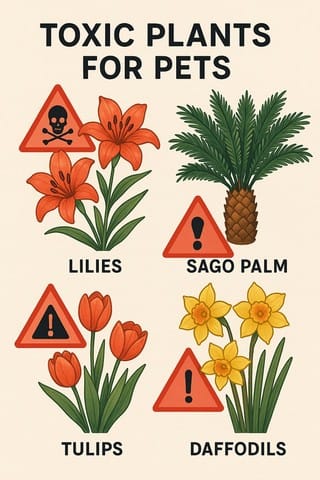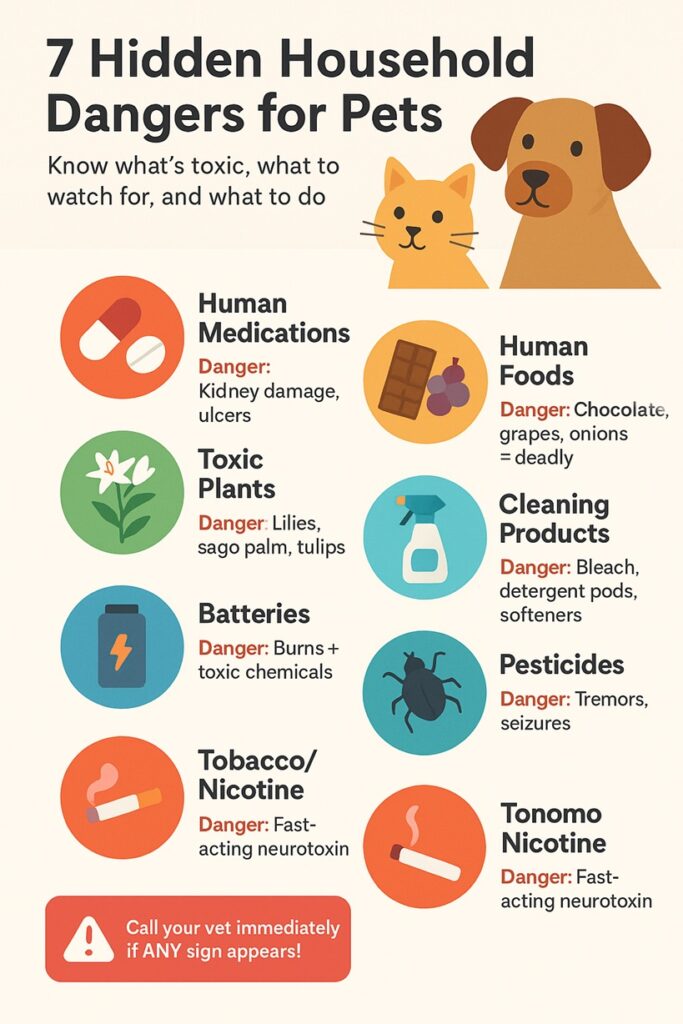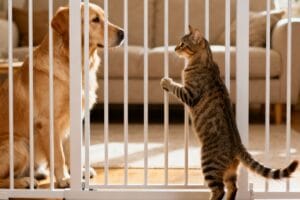If you are a pet owner, your home is a sanctuary for your pet. We care for them and provide them with food, love and toys. But what about the hidden dangers lurking in your home that can be harmful to your pet?
Dreamy Mammals understands this dilemma that almost every pet owner faces. Our homes stock several items that may appear to be harmless, yet affect the health of your cats or dogs.
The Top 7 Household Toxins for Pets
| Household Item | Why is it Toxic? | Common Symptoms | What to Do Immediately |
|---|---|---|---|
| Human Medications (Ibuprofen, Acetaminophen, thyroid meds, beta-blockers, supplements) | Pets metabolize drugs differently → causes ulcers, bleeding, kidney damage, anemia | Vomiting, diarrhea, lethargy, kidney failure signs | Gather meds ingested & consult vet immediately. Do NOT force vomiting. |
| Human Foods (Chocolate, Xylitol, Grapes/Raisins, Onions, Garlic) | Chocolate → slow metabolism; Grapes/Raisins → kidney failure; Onions/Garlic → blood cell damage | Vomiting, diarrhea, weakness, kidney failure symptoms | Contact vet immediately; note amount ingested. Do NOT induce vomiting. |
| Toxic Plants (Lilies, Sago Palm, Tulips, Daffodils) | Lilies → kidney failure in cats;
Sago Palm seeds → highly toxic; Bulbs of Tulips/Daffodils → GI upset, drooling |
Lethargy, drooling, vomiting, kidney issues | Identify plant (photo/sample) & bring to vet. |
| Household Cleaning Products (Bleach, Detergent Pods, Fabric Softeners) | Bleach → mouth & esophagus burns; Detergents → chemical burns;
Fabric softeners → ulcers, GI injury |
Drooling, oral pain, vomiting, refusal to eat | Do NOT induce vomiting. Seek vet help immediately. |
| Batteries (Button cells, small household batteries) | Alkaline compounds → liquefaction necrosis (deep ulcers, burns) | Oral burns, drooling, GI distress | Do NOT induce vomiting. Rush to vet. |
| Insecticides & Pesticides (Ant baits, bug sprays, slug baits, fertilizers) | Can cause GI distress, tremors, seizures | Vomiting, seizures, tremors, weakness | Provide vet with product label, ingredients, EPA number. |
| Tobacco Products (Cigarettes, cigars, nicotine patches, e-liquids) | Nicotine = potent neurotoxin absorbed quickly | Vomiting, agitation, tremors, collapse | Bring product/packaging to vet for nicotine assessment. |
Let us now check out the most common yet dangerous toxic items for your pets. We will analyse their toxicity, symptoms and immediate care you need to take.

Human medications
What is safe for us can be dangerous and toxic for your pets. Both common over-the-counter medicines and prescribed medications can pose a danger to the pets. The problem lies in how pets metabolise the drugs when compared to humans. According to ASPCA portal, over-the-counter medications cause more than 16% fatalities in pets.
Imagine a safe dosage of Ibuprofen for humans. A two-tablet dose for humans is considered safe for humans, But the same dose can be 15 or even 25 times higher than a safe dose for a pet. This vast difference should make you understand the severity of the medications.
-
A safe two-tablet ibuprofen dose for humans can be 15-25 times higher than a safe dose for pets
-
Acetaminophen (Tylenol) causes red blood cell damage and anemia in cats
-
Even vitamins and supplements pose significant risks when ingested by pets
⚠️ Critical Warning: Never give human medications to pets. The dosage differences can be fatal.
Why are they toxic? – An overdose can cause severe stomach and intestinal ulcers, bleeding, intestinal perforation, and permanent kidney damage. Acetaminophen (Tylenol) is dangerous for cats and leads to red blood cell damage or anaemia. A wide array of other human medications, including birth control, ACE inhibitors, beta-blockers, thyroid hormones, cholesterol-lowering agents, and various dietary supplements, can also pose toxicity risks.
What to do – Gather all medications ingested and consult the vet immediately. Do not force vomiting.
A Quick Insight
Have you ever given human medications to your pets? Stop it – Human drugs are never advisable for pets, as you do not have an idea of the right dosage.
Some Human Foods
This is one of the common habits we pet owners tend to exhibit. If our pet approaches us when we are eating, we simply share whatever we are eating. But have we ever given a thought to finding if the human food is suitable for the pet?

Some human foods that are considered dangerous for our pets include Chocolate, Xylitol, Grapes/Raisins, Onions and Garlic. So common for us humans, right? But they can be silent killers for our pets. This highlights a common misconception that if a food is good for a person, it must be good for their pet.
-
Mortality rate from chocolate poisoning is less than 3% with proper treatment, according to ACVP portal.
-
Dogs ingesting higher doses of chocolate are significantly more likely to develop clinical signs
-
Common symptoms include agitation (75% of symptomatic cases), tremors (50%), and vomiting (48%)
Xylitol is extremely dangerous, with research showing that even small amounts can cause severe hypoglycemia within 30 minutes to 2 hours. Studies indicate that 15% of dogs exposed to xylitol become hypoglycemic during veterinary evaluation.
Why it is toxic – Pets metabolise chocolate really slower. Raisins and grapes can cause kidney failure in dogs. Onions, Garlic, Leeks, Chives, and Shallots can cause blood cell damage in cats and dogs.
What to do – IMMEDIATELY contact your veterinarian. In the case of chocolate, estimate the amount ingested. Once again, do not induce vomiting.
Toxic plants
Some plants can be dangerous and even toxic to our pets. This can include the plants that we grow indoors or those in our garden. If you have curious pets like cats, this can reach dangerous proportions.

A few plants that can be toxic for your pets include Lilies (Day Lilies, Easter Lilies, Oriental Lilies), Sago Palm, Tulips and Daffodils. Pet owners should be aware that even proximity to certain plants, such as pollen exposure, can be enough to cause severe reactions in susceptible animals.

Why is it toxic – Lilies cause severe kidney failure and, tragically, death in cats. The effect is not known on dogs. Sago Palm is quite dangerous for pets, especially its seeds are known to be quite toxic. Bulbs of Tulips and Daffodils can cause severe gastrointestinal upset, excessive drooling, and lethargy.
What to do – If plant ingestion is suspected, try to identify the specific plant. Taking a photo or bringing a small sample can be incredibly helpful for the veterinary team.
Household cleaning products
The household cleaning products are quite ubiquitous in every home. They are essential for our homes and are readily available to the pets. This can result in severe issues for your favourite pet.
-
Bleach: Causes severe mouth and esophagus burns, as per the reports in Nature.
-
Laundry Detergent Pods: Result in chemical burns and stomach upset
-
Fabric Softeners: Cause severe ulcers in mouth, esophagus, and stomach
Critical Point: Never induce vomiting with corrosive substances as this can cause additional damage to the esophagus.
Some of these products can include Bleach, Laundry Detergent Pods, and Fabric Softeners. The danger from these items is often a dual hazard, involving both chemical toxicity and the risk of physical obstruction from ingested packaging
Why it is toxic – Bleach can cause severe injury to the mouth and esophagus. Laundry detergents can result in stomach upset, irritation, and chemical burns to the mouth and throat. Fabric softeners result in severe chemical burns and ulcers to the pet’s mouth, oesophagus, and stomach.
What to do – DO NOT induce vomiting. For corrosive substances, inducing vomiting can cause further, severe damage to the oesophagus and gastrointestinal tract on the way back up.
Batteries
Batteries are another safety hazard for cats and dogs. This is more so with the small batteries and button cells. These are another common item that is found in homes because of their presence in toys, electronic items and watches.
They can be easily accessible for the pets. Battery ingestion presents a dual hazard: chemical toxicity from their contents and the risk of physical obstruction or burns.
Why is it toxic – The alkaline compounds in the battery causes severe damage to the mucous membranes in the mouth and gastrointestinal system, a condition known as liquefaction necrosis, leading to deeply penetrating ulcers that can form over several hours.
What to do – For corrosive substances like battery contents, inducing vomiting can cause further, severe corrosive damage to the esophagus and gastrointestinal tract as the material comes back up. This is a critical distinction from other toxins where vomiting might be recommended, underscoring the need for professional assessment for corrosive ingestions.
Insecticides and pesticides
Insecticides and pesticides are commonly used in and around the home to control pests, but they can be highly enticing and dangerous to pets.
These products include a wide range of chemicals found in ant baits, bug sprays, slug and snail baits, and lawn fertilisers. Accidental exposure due to improper storage, application, or pet curiosity is a frequent concern.
Why it is toxic – They can cause gastrointestinal distress. Some compounds can cause severe neurological signs, including tremors and seizures.
What to do – It is crucial to provide the exact product name, active ingredients, and EPA registration number from the product label. This specific information is vital for the veterinary team to determine the appropriate course of treatment.
Tobacco Products
Tobacco products, including cigarettes, cigars, chewing tobacco, nicotine patches, and e-liquids, contain nicotine, a potent neurotoxin that can be highly dangerous to pets. Nicotine is rapidly absorbed into the bloodstream.
Cigarette butts that we discard may contain a significant percentage (up to 25%) of the total nicotine from the cigarette. Thus, even a seemingly harmless discarded item may also cause severe effects in your pets.
Why is it toxic – Nicotine acts on the nervous system, causing a range of effects from stimulation to depression, depending on the dose.
What to do – If possible, bring any remaining product or packaging to the veterinary professional for assessment of the nicotine content and type of product ingested.
When to Seek Urgent Veterinary Care: Don’t Wait!

It is essential to identify the symptoms of pet emergency urgently. It is imperative not to wait for symptoms to worsen, as early intervention is often the most critical factor in a positive outcome for poisoning cases.If you notice any of these symptoms and signs, it is imperative to get in touch with your veterinary care –
- Ingestion of ANY suspected toxic substance: Even if a pet appears fine immediately after ingestion, early intervention can be life-saving for many toxins. This is more so with the items with delayed onset of severe symptoms.
- Repeated or severe vomiting or diarrhea: Especially if blood is present, or if the pet is becoming visibly dehydrated.
- Sudden collapse or loss of consciousness: Any unexplained loss of consciousness is an emergency.
- Seizures or tremors: Even a single occurrence warrants immediate veterinary evaluation.
- Difficulty breathing, wheezing, or excessive coughing: These can indicate severe respiratory distress.
- Extreme lethargy, profound weakness, or uncoordinated movement: These are often signs of systemic toxicity.
- Signs of extreme pain: This may show itself as whining, excessive panting, aggression, or an inability to put weight on a limb.
- Bloated or distended abdomen: This can indicate life-threatening conditions like bloat (gastric dilatation-volvulus).
- Changes in urination or defecation: Particularly an inability to urinate, which can signal kidney failure.
- Oral irritation, excessive drooling, or burns around the mouth: These are common with corrosive ingestions.
- Any other sudden, unexplained change in behavior or health: Pet owners should trust their instincts; if something seems wrong, it likely is.
✅ Store all medications in secure, closed cabinets
✅ Keep human foods out of pet reach
✅ Research plants before bringing them into your home
✅ Store cleaning products in locked cabinets
✅ Properly dispose of batteries and electronic waste
✅ Secure pesticides and rodenticides away from pets
✅ Never leave tobacco products accessible
The Golden Rule: The sooner poisoning is diagnosed and treated, the better the prognosis. Always have the emergency number readily available, and remember: when in doubt, contact a veterinary professional immediately. This proactive approach to emergency care is paramount, as delaying treatment can lead to irreversible damage or fatal outcomes.
Conclusion
Our homes may be filled with comfort and joy for our pets. But, they can also have a huge list of harmful items that can severely harm them. Understanding the common harmful items for the pet cats and dogs can help you address them more efficiently.
Dreamy Mammals urges all pet parents to share this vital information with other pet owners. Keep the emergency number in your region handy, and remember the golden rule: when in doubt, contact your veterinarian or a poison control center immediately. Your furry friend is counting on your vigilance and swift action to keep them safe and healthy.




Add Comment